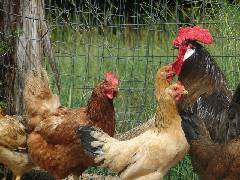How to Choose and Look after Chickens
Advice


Although smallholding does not imply any requirement to keep livestock most smallholders do keep some and most smallholders do begin with chickens.
Chickens were one of the first animals to be domesticated way back in our distant past, and this was for more than one reason. Chickens are by far the least dangerous of all the domesticated animals we do keep, they are very productive both for meat and eggs – but they do have their drawbacks.
The Upside
Chickens, when chosen well, will provide a small family with all the meat and eggs they need on little more than the area of the average garden, they are easily contained in movable arks (small mobile homes with both protection from the elements and an outdoor run.) These can be constructed easily by anyone with the inclination and a few basic tools, for far less than a shop bought mass produced unit.
Choosing your chickens is the key to success; if you are looking for just meat then commercial breeders have perfected some hybrid chickens, which put on weight very quickly. I believe however that this tendency to gain weight quickly in any type of hybrid stock is detrimental to the true flavour of the meat.
Choosing your chickens for good egg production has similar drawbacks many of today modern hybrid chickens will lay more than 300 eggs per year, they will even lay 300 good quality eggs. But they are often incapable of reproduction without assistance, and you will need to either keeping a few of an older breed just to sit on your eggs for replenishing your stock, or buying an incubator to artificially incubate your eggs. Both of these methods of preproduction will come at a cost, both financial and personal inconvenience. Paying to feed an older breed of hen that will go broody readily but not produce as many eggs as the hybrid is costly, an incubator is to my mind expensive and artificial, the personal cost comes in the form of failure as both hens and incubators fail at times.
For my own needs and my recommendation would be to choose an old breed that has proven to be a good dual purpose breed, i.e. will provide you with both good meat and a reasonable amount of good quality eggs. There are as with all choices drawbacks and compromises to be made, but in my opinion the pluses outweigh any of the drawbacks.
The Downside
Chickens are easily lost; the array of diseases is vast and complicated. Chickens do not readily show any sign of some of the more deadly diseases and complaints that they suffer from so often the first sign of something being wrong is finding your chicken dead. I do not however see this as a reason not to keep them as they can be easily fed and provided for without drastic losses.
The second, and possibly greatest, danger is predators; even the most aggressive cock will not stop your whole henhouse being wiped out by a fox in one night.
Rats, martins, buzzards and polecats will also all take chickens or their offspring. Again none of these are a reason not to keep them but your management of chickens will need to take all these considerations into account.
The different breeds
Orpington’s are my own choice of purebred chickens but all of the following and more are available here in France and many would make ideal Smallholder stock.
Orpington
Varieties:
- Black
- Blue
- Buff
- White
Standard Weights: Cock-10 pounds; hen-8 pounds
Skin Colour: White.
Egg Shell Colour: Brown.
Use: A heavy dual-purpose fowl for the production of both meat and eggs.
Sussex
Varieties:
- Speckled
- Red
- Light
Standard Weights: Cock-9 pounds; hen-7 pounds;
Skin Colour: White.
Egg Shell Colour: Brown.
Use: A general-purpose breed for producing meat and/or eggs, one of the best of the dual-purpose chickens, a good all-around farm fowl.
Brahma
Varieties:
- Light
- Dark
- Buff
Standard Weights (Light): Cock-12 pounds; hen-9-1/2 pounds;
Standard Weights (Dark and Buff): Cock-1 1 pounds; hen-8-1/2 pounds;
Skin Colour: Yellow.
Egg Shell Colour: Brown.
Use: A very heavy fowl for the production of heavy roasters, fair egg layers.
Wyandotte
Varieties:
- White
- Buff
- Columbian
- Golden Laced
- Blue
- Silver Laced
- Silver-Pencilled
- Partridge
- Black
Standard Weights: Cock-8-1/2 pounds, hen-6-1/2 pounds,
Skin Colour: Yellow.
Egg Shell Colour: Brown.
Use: Meat or eggs.
There are, of course, more to choose from but these are my favourite breeds and all are proven in their ability to produce excellent quality meat and eggs, as well as reproduce readily and without assistance of any kind.
You will of course still suffer the inevitable failures of hatching but these breeds will prove to be a pleasure to keep, and of course the eggs will provide for your needs in cooking as well as reproduction, and the meat will be a pleasure to eat; flavoursome and firm to the bite a complete contrast to cheap supermarket chicken.
Feeding
Feeding can be as simple or as complex as you wish to make it. Preparatory feeds are available and these will take care of all of your chickens’ needs but for me this is far from ideal as most super markets sell cheap chicken and eggs that have been fed by exactly this means.
For me the joy of smallholding is the superior quality food I enjoy from my livestock, and this is due to an approach that takes care of my animals at a much higher standard than that of truly commercial factory farms. Smallholders can of course take the same factory farm approach to their livestock but it is not an approach I advocate or think most of you would want.
Feeding your chickens should take care of all of the nutritional needs they have as well as give them a wide variety. Good quality high protein grains are the main stay of any poultry species food needs.
Barley is one of the best of these grains and would take care of most of your chickens needs regardless of whether they are egg layers or meat birds. Maize, however, will give the meat of any chicken a different richer colour and taste.
I have fed free-range chickens on a mix of barley and maize as well as food they can forage from their surroundings and they are hard to beat for flavour or texture, and the eggs from birds fed on the same diet will be unbeatable for flavour.
I have experienced a drop off in egg production in birds fed on the same diet for six months or more and simply feeding them on a different grain such as wheat for a month or so seems to bring the production back up again. My policy is now to change the diet of my egg laying birds regularly avoiding the drop in production.
Two very important feeding tips not to forget!
- Chickens need water; it’s obvious I know but if you forget you will pay in more ways than one. Bird health, weight, egg production will all be affected if you do not give them a plentiful supply of clean water. You could find your birds dead.
- Chickens need grit. This one is not so obvious but it is nearly as important as water. Your birds could be on the best diet in the world but if they don’t have grit they will not be able to digest their food. You can buy crushed oyster shell and mix it with their food but this is not necessary if you simply feed them on the ground they will take up soil and grit. This will suffice but of course you will have to always feed them in a different place so the ground does not become a desert or infected.
Housing needs
Chickens need housing for many reasons, and to be honest most of these reasons are orientated toward human management needs rather than to meet the birds needs. Chickens can and do fair very well on their own without any housing at all – they can, for instance, avoid predators very affectively by roosting high in trees well before dark. Chickens can also tolerate both high and low extremes of temperature without detrimental effects to their health or longevity.
However chickens kept for food production in some kind of enclosure without trees to roost in will need a secure house to protect them, with somewhere to roost as high as possible even if only a foot or so off the floor. If you do allow them to roost in trees and do not provide housing they will also lay their eggs all over the enclosure in any dark secluded place they can find, and you may not find the eggs.
A house with roosting perches and nesting boxes that they can lay in is ideal but it has to be impervious to all of the predators mentioned earlier. This normally means you will need to open the house to let the birds out and lock them back in again just before dark. This is a routine that requires some discipline as many a smallholder has lost their hens the night they did not lock the henhouse after they returned late from a party, or the weather was just to foul to go out in.
Reproduction needs to be taken in to account if you wish to have your own hens hatch their own eggs. To help in this a separate house or ark for your broody hen will avoid your broody hen being bullied off of her nest by a more dominant bird. Even if she is only bullied off for a few minuets a day she may hatch her own eggs successfully but all the eggs laid after the first day or so of incubation will be left to die. This will, of course, adversely affect the success rate of your reproduction program.
Bathing
One last consideration: chickens need to bathe not in water but in grit or fine sand. Silver sand is superb for this but you must keep it dry. Chickens will roll over in the sand and let it trickle down through their feathers cleaning their feathers, skin, and carrying away parasites.
Steve Hanson
Share to: Facebook Twitter LinkedIn Email
More in courses, family, food, garden, health, markets
By FrenchEntrée
Leave a reply
Your email address will not be published. Required fields are marked *



